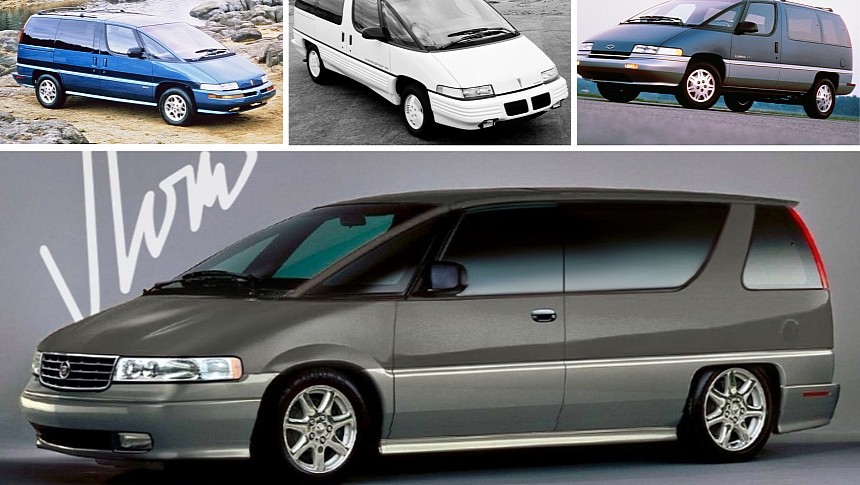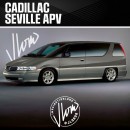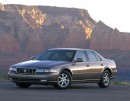In the late 1970s, Chrysler began working on a small, more affordable van that fitted in a typical garage and looked and handled more like a car. The project came to fruition in 1983 as the Dodge Caravan and its Plymouth twin, the Voyager. The design proved very popular, and the minivan craze began.
In response to the hugely popular Dodge Caravan, General Motors introduced the Chevrolet Astro and GMC Safari twins in 1985. Ford launched the Aerostar in 1986. However, while these haulers were indeed smaller than regular vans, they were still bigger than the Chrysler minivans and featured a traditional rear-wheel drive layout. It wasn't until the 1990s that GM and Ford produced proper car-like minivans with front-wheel drive.
Mercury launched the Villager in 1992. Based on the Nissan Quest, it was the first Mercury produced without a Ford counterpart since 1960. Ford eventually introduced its own minivan, the Windstar, in 1994. Sharing underpinnings with the Taurus, it was unrelated to the Mercury Villager.
General Motors arrived earlier at the minivan party by launching the Chevrolet Lumina APV for the 1990 model year. The first American minivan to adopt the design and FWD layout of the Dodge Caravan, the Lumina APV debuted alongside the Pontiac Trans Sport and Oldsmobile Silhouette.
Unlike Ford, GM opted to use three brands with distinctive marketing objectives in the minivan market. While the Lumina APV was designed to compete against the Dodge Caravan and a volume model, the Silhouette was conceived as a more luxurious trim to go against the Chrysler Town & Country that Mopar unveiled in 1989. Finally, the Pontiac Trans Sport pioneered a new niche of sporty-looking minivans.
The Lumina APV was the shortest-lived nameplate, exiting the market in 1996. It was replaced, however, by the Venture. The latter remained in showrooms until 2005, when Chevy launched the Uplander, built until 2008. The Pontiac Trans Sport was replaced by the Montana in 1998, which was discontinued in 2008, two years before General Motors closed the Pontiac brand.
The Oldsmobile Silhouette, on the other hand, lived to see two generations and remained in showrooms until the company was sent into the history books in 2004. Although it was nowhere near as successful as its Chevrolet counterpart, the Silhouette moved more than 30,000 units per year in the late 1990s and early 2000s. And those production figures were large enough for GM to continue offering a premium minivan in the Buick Terraza, albeit only until 2007.
And this brings me to a question I've been asking myself ever since GM abandoned the minivan market: why wasn't there a truly luxurious version with a Cadillac badge? Sure, Cadillac had introduced the Escalade in 1998, but I'm sure some folks would have preferred a roomy hauler that handled like a car instead of a big and heavy truck. Moreover, while the first-gen Escalade was a five-seat rig, the Cadillac minivan could have easily borrowed the layout of its GM siblings and offered seating for up to seven people.
Equipped with all the cool features available in Cadillac cars at the time, it would have been the fanciest minivan out there. And perhaps it would have been the first minivan available with a V8 engine. The rendering you see here, provided by Instagram's "jlord8," marries the body of a 1990s GM minivan to the front fascia of a Seville sedan.
Plus a nicely reworked glasshouse with rearward-slanted C-pillars and no B-pillars. Add the Seville's 4.6-liter Northstar V8 engine into the mix, and you get a mighty attractive package. I mean, who doesn't want a 300-horsepower minivan to haul the entire family across the US?
But of course, I'm talking about a vehicle that was never on GM's drawing board, so all we can do is ogle at this rendering and complain about Detroit not giving us the minivan we deserve. This and the Hellcat-powered Crysler Pacifica.
Mercury launched the Villager in 1992. Based on the Nissan Quest, it was the first Mercury produced without a Ford counterpart since 1960. Ford eventually introduced its own minivan, the Windstar, in 1994. Sharing underpinnings with the Taurus, it was unrelated to the Mercury Villager.
General Motors arrived earlier at the minivan party by launching the Chevrolet Lumina APV for the 1990 model year. The first American minivan to adopt the design and FWD layout of the Dodge Caravan, the Lumina APV debuted alongside the Pontiac Trans Sport and Oldsmobile Silhouette.
Unlike Ford, GM opted to use three brands with distinctive marketing objectives in the minivan market. While the Lumina APV was designed to compete against the Dodge Caravan and a volume model, the Silhouette was conceived as a more luxurious trim to go against the Chrysler Town & Country that Mopar unveiled in 1989. Finally, the Pontiac Trans Sport pioneered a new niche of sporty-looking minivans.
The Lumina APV was the shortest-lived nameplate, exiting the market in 1996. It was replaced, however, by the Venture. The latter remained in showrooms until 2005, when Chevy launched the Uplander, built until 2008. The Pontiac Trans Sport was replaced by the Montana in 1998, which was discontinued in 2008, two years before General Motors closed the Pontiac brand.
The Oldsmobile Silhouette, on the other hand, lived to see two generations and remained in showrooms until the company was sent into the history books in 2004. Although it was nowhere near as successful as its Chevrolet counterpart, the Silhouette moved more than 30,000 units per year in the late 1990s and early 2000s. And those production figures were large enough for GM to continue offering a premium minivan in the Buick Terraza, albeit only until 2007.
And this brings me to a question I've been asking myself ever since GM abandoned the minivan market: why wasn't there a truly luxurious version with a Cadillac badge? Sure, Cadillac had introduced the Escalade in 1998, but I'm sure some folks would have preferred a roomy hauler that handled like a car instead of a big and heavy truck. Moreover, while the first-gen Escalade was a five-seat rig, the Cadillac minivan could have easily borrowed the layout of its GM siblings and offered seating for up to seven people.
Equipped with all the cool features available in Cadillac cars at the time, it would have been the fanciest minivan out there. And perhaps it would have been the first minivan available with a V8 engine. The rendering you see here, provided by Instagram's "jlord8," marries the body of a 1990s GM minivan to the front fascia of a Seville sedan.
Plus a nicely reworked glasshouse with rearward-slanted C-pillars and no B-pillars. Add the Seville's 4.6-liter Northstar V8 engine into the mix, and you get a mighty attractive package. I mean, who doesn't want a 300-horsepower minivan to haul the entire family across the US?
But of course, I'm talking about a vehicle that was never on GM's drawing board, so all we can do is ogle at this rendering and complain about Detroit not giving us the minivan we deserve. This and the Hellcat-powered Crysler Pacifica.








